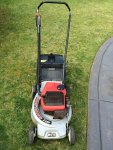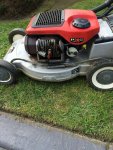bertsmobile1
Lawn Royalty
- Joined
- Nov 29, 2014
- Threads
- 64
- Messages
- 24,705
And you sound suprised ?
Horse power can be calculated at least a dozen different ways and there are almost as many different ways to measure it.
Mower engines are by and large not high horsepower .
Further more the world finally came to an agreement as how to rate the energy developed by small engines, one of the nice spin offs of the WTO so I have been told.
So when you are measuring a small item it makes good sense to use a small unit of measurement.
Under the old system those motors would have been rated as 3.75 , 4 & 4,5 Hp respectively.
Under the new system they would be rated something like 2.75, 2.9 & 3.1 Hp so naturally the need to change the publicised power measurements.
Much like the old days when cc for cc Honda engines were around 10% to 15% lower rated Hp than Briggs because principally they were being measured differently.
Nothing has physically changed, just the way we describe them but it is almost impossible for Joe public to backwards convert their old engines power ratings to compare them with the modern ones.
Under the new systen the Powertorque figures I quoted before would be around 30% lower, but that is not the way I remember them.
For industral engines you want flat power delivery at the best or a strait upward curve at the worst.
You do not want your mowers power to halve suddenly when you push it into the tall tufty wet grass and it slows down the engine slightly.
So if you for instance push your mower hard and regularly submit it to high loads that are likely to slow it down then you need the engine which developes peak power a bit lower down so as the engine is slowed by the load it adds a bit more oomph which is what the latter two curves show.
Back in the bad old side banger days you could get engines in 0.25 Hp increments but when you had a good look there were 6 to 8 different engines that all had the same piston, stroke, compression ratio, valve size , cam & carb size.
The difference ?
The size of the main jet.
The actual difference in performance 5/8 of SFA
But the sales person could convince you that the extra 1.5Hp was worth the extra 20% on the price tag.
Remember the mower engines are made for the mower companies not the end user.
Horse power can be calculated at least a dozen different ways and there are almost as many different ways to measure it.
Mower engines are by and large not high horsepower .
Further more the world finally came to an agreement as how to rate the energy developed by small engines, one of the nice spin offs of the WTO so I have been told.
So when you are measuring a small item it makes good sense to use a small unit of measurement.
Under the old system those motors would have been rated as 3.75 , 4 & 4,5 Hp respectively.
Under the new system they would be rated something like 2.75, 2.9 & 3.1 Hp so naturally the need to change the publicised power measurements.
Much like the old days when cc for cc Honda engines were around 10% to 15% lower rated Hp than Briggs because principally they were being measured differently.
Nothing has physically changed, just the way we describe them but it is almost impossible for Joe public to backwards convert their old engines power ratings to compare them with the modern ones.
Under the new systen the Powertorque figures I quoted before would be around 30% lower, but that is not the way I remember them.
For industral engines you want flat power delivery at the best or a strait upward curve at the worst.
You do not want your mowers power to halve suddenly when you push it into the tall tufty wet grass and it slows down the engine slightly.
So if you for instance push your mower hard and regularly submit it to high loads that are likely to slow it down then you need the engine which developes peak power a bit lower down so as the engine is slowed by the load it adds a bit more oomph which is what the latter two curves show.
Back in the bad old side banger days you could get engines in 0.25 Hp increments but when you had a good look there were 6 to 8 different engines that all had the same piston, stroke, compression ratio, valve size , cam & carb size.
The difference ?
The size of the main jet.
The actual difference in performance 5/8 of SFA
But the sales person could convince you that the extra 1.5Hp was worth the extra 20% on the price tag.
Remember the mower engines are made for the mower companies not the end user.


